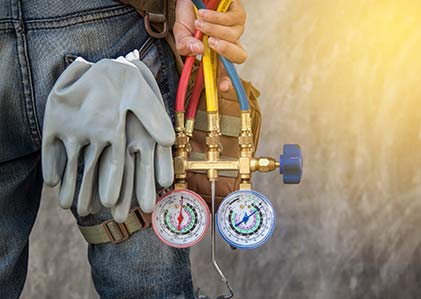How to Become an HVAC Project Manager
There is no formal process, nor just one path to becoming an HVAC program manager. This lack of formalized training to get the role provides experienced HVAC technicians with a wide range of ways to advance into project management. The following details the pathways someone could take to become an HVAC project manager.
Step 1: Graduate from high school (four years)
While in high school, it helps to take math, physics, and vocational education courses. Classes like automotive tech, woodshop, or electrician courses can be good training for the physical and problem-solving skills that professionals need to become competent and productive HVAC technicians. If a student knows that management is their ultimate goal, having a bachelor’s degree (while not necessary) may be a competitive advantage. Students should plan course loads accordingly.
Step 2: Graduate from an apprenticeship program or pursue a certificate, associate degree, or bachelor’s degree in HVAC (six months to five years)
Experience as an HVAC technician is necessary to become a project manager, and training is needed to become an HVAC technician. Which program a future HVAC technician chooses will depend on who they are as a student.
Those interested in getting to work as soon as possible after graduation can choose the apprenticeship route if it is available in their state. Apprenticeships are hands-on, in-the-field learning programs where new HVAC techs spend three to five years learning the trade in the real world with experienced HVAC technicians. Depending on the state requirements, may also need to complete classroom work. In some states, a completed apprenticeship is adequate to apply for licensure.
If no apprenticeship programs are available, the next-quickest route to work is through diploma, certificate, or vocational programs. These programs can last six months or more. Of the school-based routes, these programs tend to be the most affordable.
The Refrigeration School
One such example is at the Refrigeration School in Phoenix, Arizona. Its refrigeration technologies training program trains and prepares HVAC students for entry-level employment as maintenance and service technicians in jobs that utilize technologies employed in the HVAC-R field. Incorporating a hands-on curriculum with real-world training, this program offers both day and evening classes and can be completed in just six months.
Focussing on the fundamentals of refrigeration and comfort systems, this refrigeration technologies training program includes courses such as the fundamentals of electricity; fundamentals of refrigeration; comfort systems – residential; comfort systems – commercial; refrigeration systems and practices; and advanced troubleshooting techniques.
- Location: Phoenix, AZ
- Accreditation: Accrediting Commission of Career Schools and Colleges (ACCSC)
- Expected Time to Completion: Six months
Future HVAC techs interested in gaining a wider breadth of training before starting work can pursue an associate of applied science in HVAC. In addition to HVAC requirements, associate degrees may require students to complete some general education requirements like English and math. Most AAS degrees offer more coursework than certificates, degrees, and diploma programs, which give future HVAC techs a broader taste of the field. Although it varies from program to program, AAS degrees generally take two years to complete. Some AAS programs also allow students to specialize in residential versus commercial HVAC, like those available at Central New Mexico Community College.
Central New Mexico Community College
Students at Central New Mexico Community College’s HVAC-R program will be trained to operate and maintain several types of HVAC-R systems and accessories. The college offers the following three programs:
- Residential HVAC – Certificate of Completion (23 credits)
- Commercial, Industrial HVAC & Building Performance – Certificate of Completion (47 credits)
- HVAC-R Technology – Associate of Applied Science (65 credits)
The curriculum includes courses such as refrigerant fundamentals; basic electricity; refrigerant management; motors & controls; code and safety; air conditioning and controls; heating and heating control systems; advanced hydronics and controls; hot water & steam generation systems & controls; refrigeration application; industrial refrigeration; and energy efficiency & green building standards, among others.
- Location: Albuquerque, NM
- Accreditation: Higher Learning Commission (HLC); HVAC Excellence
- Expected Time to Completion: Residential HVAC (two terms); Commercial, industrial HVAC & building performance (four terms); AAS degree (five terms)
Finally, future HVAC project managers can also choose bachelor’s degrees specifically in HVAC or can choose to study mechanical engineering. Students who want a well-rounded education that allows for the in-depth study of HVAC equipment and processes are those who may want to choose the bachelor’s route. Bachelor’s degrees take four years to complete, require the greatest number of courses to complete, and are typically the priciest of the three options. That said, bachelor’s degrees may also make a candidate more competitive in the job market.
Most HVAC programs are campus-based and require in-person attendance, but some programs, like the bachelor of science (BS) in HVAC-R engineering technology at Ferris State University, are offered online.
Ferris State University
Ferris State University offers an online bachelor of science program in HVAC-R engineering technology and energy management. This project-focused program offers much more than traditional diploma or certificate programs, focusing on producing experts in HVAC design, retrofitting, testing, controls, and other related skills.
The program also includes a seven-day summer residency for labs. Students enrolled in this program must also complete a summer internship. Only associate degree holders will be eligible to apply for this program.
The program, which comprises 124 credits, includes courses such as control theory and application, HVAC systems design using business information modeling (BIM), HVAC hydronic systems selection and design, load analysis and energy modeling, direct digital control, and contracting issues in HVAC-R.
- Location: Big Rapids, MI
- Accreditation: Higher Learning Commission (HLC)
- Expected Time to Completion: 48 months
Step 3: Earn all necessary certifications and licenses (timeline varies)
For any technicians who perform maintenance, service, or repairs on, or dispose of equipment with the potential to release ozone-depleting refrigerants into the atmosphere, EPA section 608 Technician Certification is required. Depending on the types of equipment an HVAC tech decides to work with, they may need to earn multiple certifications:
- Type I – Small appliances
- Type II – High-pressure appliances
- Type III – Low-pressure appliances
- Universal – All types of equipment
In addition to EPA requirements, each state has individualized requirements for licensure. HVAC techs should ensure they understand and acquire the correct license for the state in which they plan to work.
Highly motivated HVAC techs looking to distinguish themselves in current positions or impress future employers can earn specialist or high-level certifications from North American Technician Excellence (NATE) or HVAC Excellence.
Step 4: Work as an HVAC tech and volunteer for higher-level tasks (up to five years)
The most important stepping stone to managing others is to have the experience and knowledge required to face common issues on the job. Because HVAC is applicable to a wide array of industries, time spent working will also help HVAC techs gain specialized knowledge that is often valued by a project manager. Specialized knowledge can also help a technician garner a higher salary as a tech and a manager. For example, according to PayScale.com (April 2024), HVAC service techs with commercial skills made more than those with residential skills.
While on the job, techs interested in project management should also develop interpersonal and leadership skills. Hopeful HVAC managers should volunteer for opportunities to do client-facing, organizational, and team-lead tasks and offer assistance to current project managers. Engaging in tasks like these can accelerate an HVAC tech’s pathway to project management by demonstrating leadership capacity.
Step 5: Climb the ranks or apply to outside project manager positions (timeline varies)
Volunteering for high-level tasks at their current places of work may make it possible for HVAC techs to earn leadership positions within an organization. However, if an organization already has strong HVAC project leadership, there is no shortage of need for those with HVAC skills who can also lead. In April 2024, Indeed.com had over 3,000 listings for HVAC managers.



